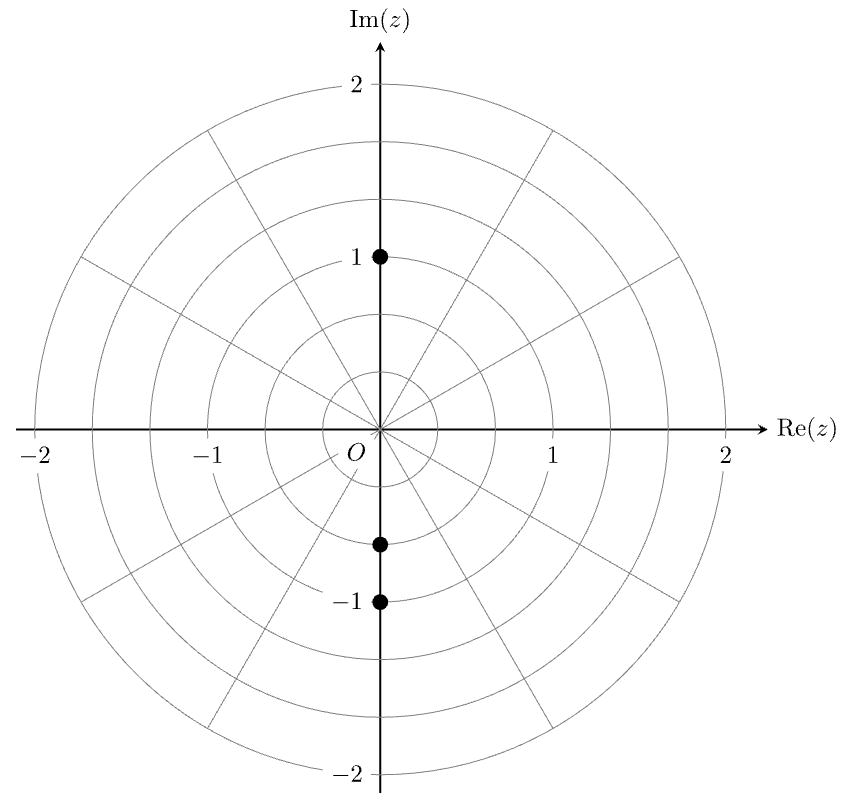Consider the function with rule \(f(z)=3 z^3+2 i z^2+3 z+2 i\), where \(z \in C\). --- 3 WORK AREA LINES (style=lined) --- --- 5 WORK AREA LINES (style=lined) --- --- 0 WORK AREA LINES (style=lined) ---
Complex Numbers, SPEC2 2020 VCAA 6 MC
For the complex polynomial `P(z) = z^3 + az^2 + bz + c` with real coefficients `a, b` and `c, P(−2) = 0` and `P(3i) = 0`.
The values of `a, b` and `c` are respectively
- `− 2, 9,− 18`
- `3, 4, 12`
- `2, 9, 18`
- `−3, −4, 12`
- `2, −9, −18`
Complex Numbers, SPEC1 2020 VCAA 3
Find the cube roots of `1/sqrt 2 - 1/sqrt 2 i`. Express your answers in polar form using principal values of the argument. (3 marks)
Complex Numbers, SPEC2-NHT 2019 VCAA 2
A cubic polynomial has the form `p(z) = z^3 + bz^2 + cz + d, \ z ∈ C`, where `b, c, d ∈ R`.
Given that a solution of `p(z) = 0` is `z_1 = 3 - 2i` and that `p(–2) = 0`, find the values of `b, c` and `d`. (4 marks)
Complex Numbers, SPEC2 2011 VCAA 8 MC
Complex Numbers, SPEC1 2012 VCAA 3
Consider the equation `z^3-z^2-2z-12 = 0, \ z in C.`
Complex Numbers, SPEC2 2016 VCAA 4 MC
One of the roots of `z^3 + bz^2 + cz = 0` is `3 - 2i`, where `b` and `c` are real numbers.
The values of `b` and `c` respectively are
A. `6, 13`
B. `3, -2`
C. `-3, 2`
D. `2, 3`
E. `-6, 13`
Complex Numbers, SPEC2-NHT 2017 VCAA 2
One root of a quadratic equation with real coefficients is `sqrt 3 + i`.
-
- Write down the other root of the quadratic equation. (1 mark)
--- 2 WORK AREA LINES (style=lined) ---
- Hence determine the quadratic equation, writing it in the form `z^2 + bz + c = 0`. (2 marks)
--- 5 WORK AREA LINES (style=lined) ---
- Write down the other root of the quadratic equation. (1 mark)
- Plot and label the roots of `z^3-2 sqrt 3 z^2 + 4z = 0` on the Argand diagram below. (3 marks)
--- 0 WORK AREA LINES (style=lined) ---
- Find the equation of the line that is the perpendicular bisector of the line segment joining the origin and the point `sqrt 3 + i`. Express your answer in the form `y = mx + c`. (2 marks)
--- 5 WORK AREA LINES (style=lined) ---
- The three roots plotted in part b. lie on a circle.
Find the equation of this circle, expressing it in the form `|z-alpha| = beta`, where `alpha, beta in R`. (3 marks)
--- 5 WORK AREA LINES (style=lined) ---
Complex Numbers, SPEC1-NHT 2017 VCAA 4
Find the values of `a` and `b` given that `z - 1 - i` is a factor of `z^3 + (a + b)z^2 + (b^2 - a)z - 4 = 0`, where `a` and `b` are real constants. (4 marks)
Complex Numbers, SPEC1 2015 VCAA 4
- Find all solutions of `z^3 = 8i, \ z in C` in cartesian form. (3 marks)
--- 7 WORK AREA LINES (style=lined) ---
- Find all solutions of `(z − 2i)^3 = 8i, \ z in C` in cartesian form. (1 mark)
--- 4 WORK AREA LINES (style=lined) ---
Complex Numbers, SPEC2 2014 VCAA 7 MC
The sum of the roots of `z^3 - 5z^2 + 11z - 7 = 0`, where `z ∈ C`, is
- `1 + 2sqrt3i`
- `5i`
- `4 - 2sqrt3i`
- `2sqrt3i`
- `5`
Complex Numbers, SPEC1 VCAA 2017 3
Let `z^3 + az^2 + 6z + a = 0, \ z ∈ C`, where `a` is a real constant.
Given that `z = 1 - i` is a solution to the equation, find all other solutions. (3 marks)
Complex Numbers, SPEC2-NHT 2018 VCAA 6 MC
Given that `(z - 3i)` is a factor of `P(z) = z^3 + 2z^2 + 9z + 18`, which one of the following statements is false?
- `P(3i) = 0`
- `P(-3i) = 0`
- `P(z)` has three linear factors over `C`
- `P(z)` has no real roots
- `P(z)` has two complex conjugate roots

